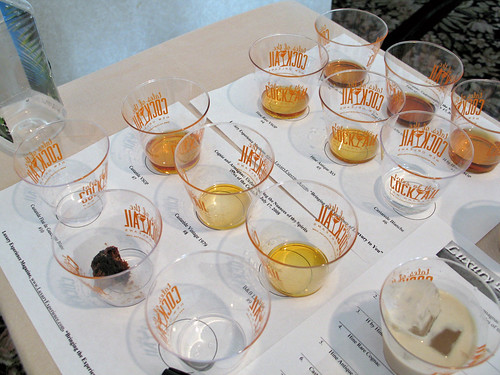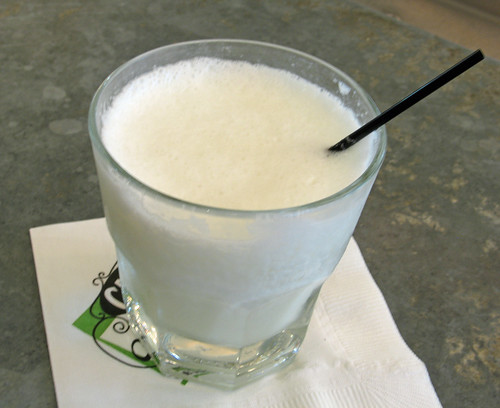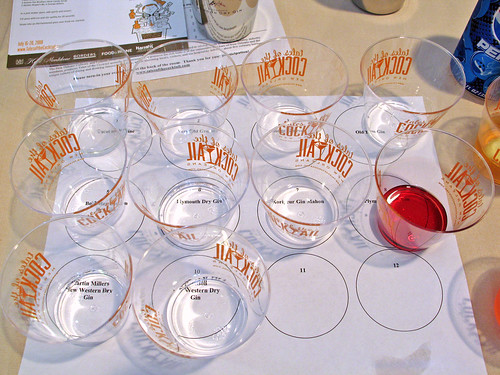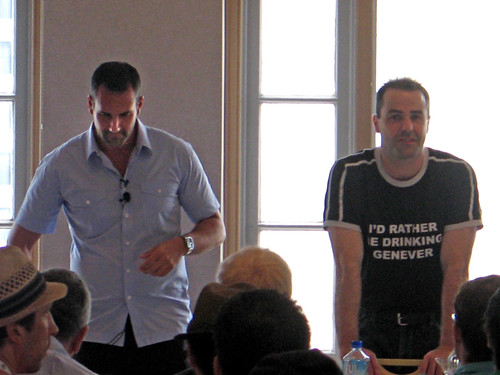Tales recap: Cognac, Armagnac and Jerez Brandy
Our third seminar at Tales of the Cocktail on Thursday, the 17th of July was entitled “Cognacs and Armagnacs,” although we sampled some lovely Spanish brandies as well.
A little quick recapping … they went through the basics — all Cognac and Armagnac is brandy but not all brandies are Cognac or Armagnac, the word “brandy” coming from the Dutch “brandwijn,” or “burnt wine”, brandy being distilled wine or, at least, fermented grape juice, sometimes with crushed grape pulp and skin, etc. Interestingly enough, some of the finest brandies are made from grapes that make lousy wine, and you probably wouldn’t want to drink the “wine” or fermented grape juice that’s the basis of many great brandies.
We got a pithy Samuel Johnson quote too: “Claret is the liquor for boys; port for men; but he who aspires to be a hero must drink brandy.” I love brandy but don’t particularly aspire to be a hero, and when I was a boy the liquor for boys was … well, whatever we could get our hands on. Miller Ponies. Everclear and Welch’s Concord Grape Juice. Old Crow and diet root beer. Anything purloined from my dad’s bar. Never once claret, though. But I digress.
Three primary types of brandies: 1) Grape brandy, usually just refered to as “brandy”; 2) Fruit brandies and eaux-de-vie, any distilled brandy made from any other kind of fruit; and 3) Pomace brandy, made from peels and skins, like Italian grappa or French marc, the quality of which can range from beautifully sublime to turpentine-like.
Three major regions of brandy-producing in Europe: Cognac and Armagnac in France, and Jerez in Spain. The revelation for me during this seminar was just getting to taste those brandies from Jerez. Gran Duque de Alba is double-distilled in pot stills from Airén grapes, which has apparently been cited as the most widely grown grape in the world (!), accounting for 30% of all grapes grown in Spain. Aged in American oak barrels that once contained oloroso sherry. We tried two, starting with the 10 year old — lght mahogany color, butterscotch in the nose, with caramel, raisins and toasted nuts, and lots of vanilla and dried fruit on the palate, with notes of chocolate and cinnamon. Yummy stuff. Then we moved on to the Gran Duque de Alba 25 year old — antique mahogany color, tons of butterscotch and toffee in the nose, with vanilla and raisins, and really smooth and lovely on the palate, with more vanilla and caramel and chocolate. I think I want me some of this stuff.
Ooh yeah, there were cocktails too.
Sidecar
2 ounces brandy (we used Gran Duque de Alba 10 year).
1 ounce Grand Marnier.
1/2 ounce fresh lemon juice.Shake and strain.
Ooh. I could get used to Sidecars like this.
Then we moved to Cognac — Ugni Blanc, Folle Blanche and Colombard grapes mostly, with high acidity and which produce “an undistinguishable wine.” Double distilled in pot stils, with the clear spirit emerging at about 68-72% alcohol, and must be aged a minimum of 2 years in French oak. If you were wondering about what the grades of Cognacs signify, here’s what they’re all about: VS or VSP means Very Superior or Very Superior Pale, which means a minimum of 4 years of aging in the cask. VSOP means Very Superior Old Pale with an average age of something between 10 and 15 years. XO means Extra Old, also referred to as Hors d’Age, which means a minimum of 6 years but often up to 20 years.
We tried H by Hine, which is a blend of 15 Petite Champagne Cognacs at least 4 and up to 7 years old. Floral and fruity on the nose, with apricot, vanilla, orange peel and jasmine in the nose, and baking spices and vanilla on the palate, with a really great texture in the mouth too. Next was Hine Rare VSOP, a blend of 25 Cognacs aged 10 or more years — vanilla, fruit and flowers in the nose, vanilla and apricot notes in the palate, very mellow and smooth. Next, Hine Antique XO, a blend of 40 Cognacs (!) from Petite and Grande Champagne, aged 20-25 years. Lots of vanilla in this one, in the nose and the palate — that’s the wood talkin’ after all those years — with dark caramel in the nose as well, and tons of spice on the palate. Very complex and pretty dry. This is $150 a bottle stuff, so I’m not likely to get a taste of it again anytime soon.
Time for another cocktail.
The Savoir Faire
1-1/2 ounces Cognac (we got H by Hine).
1/2 ounce B&B Liqueur.
1/2 ounce Pimm’s No. 1.
1 ounce tamarind juice.
1/2 ounce lemon juice.Shake and strain, garnish with a grating of nutmeg.
Pretty good, interesting tartness from the tamarind (find the juice at Latin markets if you’re interested in making this one; it’s less “juice” than the sticky tamarind pulp soaked in water, which you can do yourself if you’re so inclined but it’s a pain in the ass).
Then it was on to Armagnacs. I was keen to taste some of these, as I actually have very little experience with Armagnac and would like to have lots more. (My primary introduction to Armagnac was on an Air France flight to Russia in 1993. I don’t know about now, but at the time being on an Air France flight meant you could have all the free wine and hooch you could drink, even in coach class. I’m not sure where the spark came from, but I asked the flight attendant if I could have some Armagnac, and he quickly brought me some. I don’t even remember which one it was, but I do remember having two of them and they were lovely.) Armagnac brandies come from a different region, use similar gradings (VS/3-star, VSOP/Réserve, XO/Vieille Réserve), and the making of brandy in Armagnac predates the making of brandy in Cognac by 250 years. However, they don’t produce nearly as much; about 20 times the number of bottles come out of Cognac.
Armagnacs will also come out in specific vintages, which you don’t see nearly as often with Cognacs. I always enjoy looking at the Armagnacs in the locked cases at the spirits shop, with the prices going up and up as the vintage dates go further back. (Bottles from my birth year seem to run between $200 – 400; wonder if that was a good year.)
The three Armagnacs we tried were from the House of Castarède, founded in 1832. The first was Castarede Blanche, a white, unaged brandy which was fascinating stuff. You get none of the vanilla and spice notes as you do from the wood; this is delicate stuff, more refined than a marc but if I had to compare it to something it’d be pisco, the clear grape brandy from Peru. (I’ve always been curious about Ciroc, that grape vodka from France, but I’ve never tasted it nor do I know how it’d compare with something like this, but I’ve heard that it’s really good for a vodka.) Sweet and floral in the nose, not much alcohol burn even though it’s 40% abv. Very floral on the palate, with notes of lavender. Lovely stuff.
They used this as the base spirit in the next cocktail:
French Café Mocha
1-1/2 ounces Castarède Blanche.
1/2 ounce Fee Bros. Warm Ginger Cordial Syrup.
1 ounce cold coffee.
1 package hot cocoa.
6 ounces half-and-half.Shake and strain, serve in a rocks glass filled with ice.
This was nice, but all the delicate floral characeristics of the Blanche just went into a black hole. Frankly, a more assertively flavored and oak-aged brandy would work better in this, I think. I’d be curious to experiment with unaged Armagnac in a drink where it can really stand out.
Next up, Castarède VSOP, with walnut, warm spices, cocoa and prune in the nose, continuing in the same manner on the palate with more spices. Don’t tell me I’m going to start wanting to get Armagnacs too, sheesh …
Then, a vintage Armagnac — Castarède 1979 vintage. This stuff was superb, nuty, with butter, toasted nuts, cocoa and spices spices spices (“!!!!” is what I wrote in my notebook). Again in my head I hear the phrase, “Ooh, there goes your money, honey.” To quote Hellboy, “Ohhhh, crap.”
Finally, we tasted B&B liqueur, which stands for “Bénédictine and Brandy”, which is exactly what it is — the peerless liqueur mixed with brandy and bottled. Bénédictine had been bottled in modern times for about 70 years on its own, until a bartender at the 21 Club in New York in 1937 created a Bénédictine & Brandy cocktail, and it took off — you get the wonderful herbal bouquet of the liqueur without so much of the sweetness. The Bénédictine folks caught on to a marketable idea and began to parket the blended product as well. Oddly enough, although I love Bénédictine and use it all the time, I’d never actually tasted the bottled B&B.
OKay, the running tally for Thursday the 17th … tastes of six single malt Scotches, tastes of ten gins, four small gin cocktails, tastes of nine brandies, three small brandy cocktails. No spitting into the spit bucket at any time. From here it’s off to Cocktail Hour, and THEN to Chef Chris DeBarr’s Tiki-licious Luau Spirited Dinner, with drinks by Jeff “Beachbum” Berry and Wayne Curtis. Keep those scorecards up to date, kids …









